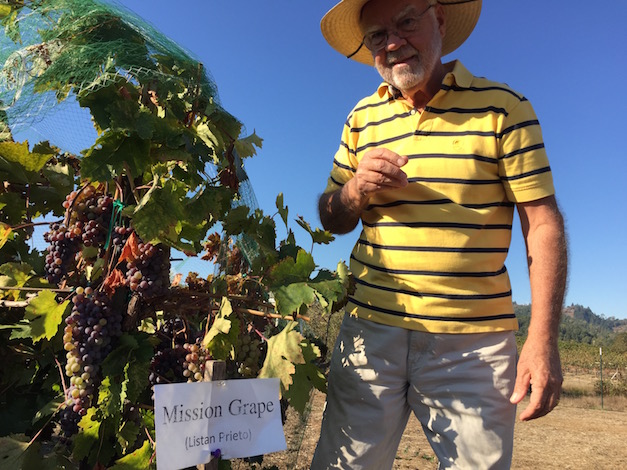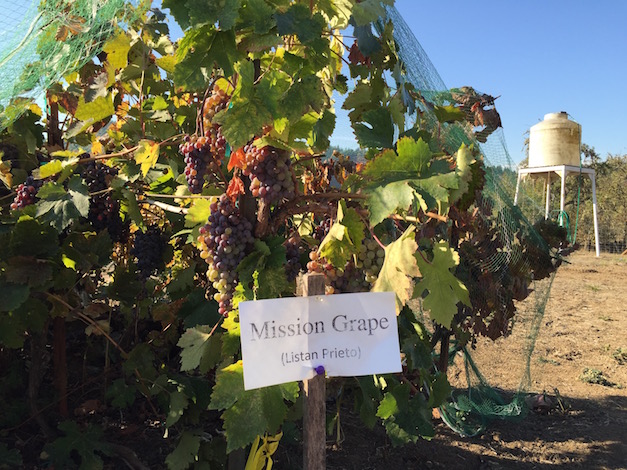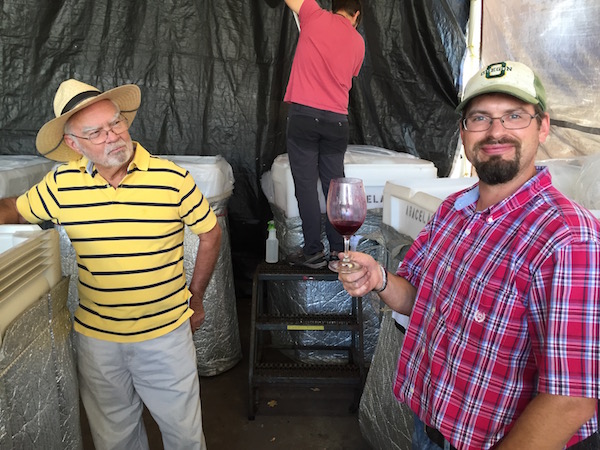
ROSEBURG, Ore. — Earl Jones moved to Southern Oregon from the Gulf Coast to begin planting Tempranillo in 1995, but he didn’t know century-old Listán Prieto grapes — a variety within the Mission family also native to Spain — already were growing at Abacela Ranch.
“We had this idea from when we were planting back 20 years ago that we were planting the first commercial wine grapes — we planted 4 acres in 1995 — and we thought that was probably the first Spanish grapes that had hit the soil,” Jones told Great Northwest Wine.
“Au contraire!” he continued. “Hidden in a blackberry thicket about a half mile from our original planting was a Spanish grape that probably came here in the 1500s — not to Oregon but the Western Hemisphere.”
Coincidentally, although Tempranillo translates to “the early one” in Spanish as a reference to its ability to ripen before many other grape varieties, it turns out the Cox family had the idea of planting wine grapes near Lookingglass Creek when it settled in the Umpqua Valley during the 19th century.
The eyes of Jones, 75, sparkle when relating the history of his property — which he purchased in 1992 — and how it relates to this fascinating discovery of Listán Prieto. He named his original planting with Fault Line Vineyards as Cox’s Rock Parcel, a 12-acre tribute to John and Elizabeth Cox, homesteaders who patented their land claim in 1853. Research by Jones has led him to believe James Cox, their son, planted an orchard and small vineyard in 1873. It’s safe to assume the second-generation farmer dabbled in winemaking.
“It’s a gross guess based on deeds and local knowledge,” Jones said.
We recently visited Jones at Abacela, near the wildlife safari in Winston, Ore. Here’s the interview:
[powerpress]
DNA analysis IDs grapes as Listán Prieto

Jones, a research dermatologist before becoming enchanted by Tempranillo, and his wife, Hilda, long have been fascinated by the heritage apple and pear trees on their estate, but they only found hints about the treasure chest of historic vines shrouded by brambleberries, occasionally seeing flares of grape leaves reaching for sunlight.
“The blackberry thicket was like a heavy fog, you couldn’t see what you were doing,” Jones said. “A bulldozer would have cleared it out in a morning, but we chose to try to identify what was in there.”
During the years, they busied themselves with developing other portions of their 400-acre estate, which has grown to 76 acres of commercial vineyard. When time permitted, Jones and his vineyard team carefully worked their way through the brier. Some of the trunks had grown as large as a man’s thigh.
“At one time, there were five grape varieties,” Jones said. “Despite us trying to be careful, we think we’re down to three varieties now.”
Some of the vines in the tiny block produced clusters that took on an appearance different than anything he’d seen before. It prompted him last year to employ the services of the University of California-Davis.
“It was a grape that none of us had any idea what variety it represented,” Jones said. “It has large clusters that ripen rather slowly and turn a pale blue instead of a deep black color. … We realized we didn’t know, so we sent it to UC-Davis for their genetic analysis. We didn’t have a suspicion they were a Spanish grape.”
Jones points out the history of Listán Prieto came to the Americas in the 1500s aboard Spanish ships carrying conquistadors and Franciscan and Jesuit missionaries.
“Listán Prieto is also known as Palomino Negra and Listán Negra,” Jones said. “Some of these grapes are collectively called the Criolla grapes or the Mission grapes. They have been used to make interesting wines in South America, in Mexico and in California, so it’s not beyond our trying to do the same thing with this Mission grape.”
Abacela embraces #UmpquaStrong effort

 No one in the Umpqua Valley community will forget Oct. 1, when an Umpqua Community College student murdered his instructor and eight classmates and wounded nine others.
No one in the Umpqua Valley community will forget Oct. 1, when an Umpqua Community College student murdered his instructor and eight classmates and wounded nine others.
“Our community will show signs of the impact of what happened on Oct. 1 for a long time,” Jones said after a long pause. “It’s just a tragedy that something like that should happen anywhere, but in a peaceful rural farming community and timber community like Roseburg? Our official population is listed around 22,000, but there are probably 50,000 living in the area around, and we are all impacted. It’s a painful wound.”
The Joneses and their winemaking intern from Spain, Asier Calvo Arroyo, were on the UCC campus that morning.
“We left about 30 minutes before the shooting began,” Jones said. “We found out about it within just a few minutes, and we were getting phone calls within a few minutes of that from reporters in New York wanting to know what I thought about it. Within 24 hours, Asier, whose home is nine hours east of here, was getting phone calls from Spanish national television and newspapers at 3 in the morning here wanting to know what he knew and if he was OK.”
To help with the recovery effort, the Joneses created a special bottling of red table wine from the 2013 vintage labeled #UmpquaStrong. Two barrels’ worth of wine — 56 cases — were released Nov. 21. They priced it at $25 per bottle, and 100 percent of the proceeds will go to the UCC Relief Fund.
It sold out in 30 hours.
Historically hot vintage at Abacela

Last year’s growing season set records throughout the Pacific Northwest, including the Umpqua Valley, but Jones noted 2015 saw more growing degree days than he’d ever seen across his Fault Line Vineyards.
“I think 2015 is going to be a very nice vintage,” he said. “It differs from 2014 although they have similar heat summations. Both are going down as very hot years. In 2014, there were very few days of maximum temperatures recorded above a 100 whereas this year had many of those. I think we had 14 or 15 (days over 100 degrees), quite a change from the year before, so I think the vines saw more heat stress and that contributed to the drought conditions.”
Abacela used about 8 percent more water for irrigation, but Jones said the drought is not seen as the culprit for the reduced crop in 2015 from Grenache, which accounts for one of the Pacific Northwest’s top rosés year after year.
“Some event during the flowering period affected fruit set for Grenache this year — so-called shatter, which that grape is famous for,” Jones said. “We’re not sure if it was a downturn in temperature in the early flowering period, which may go over 10 days. It could have been early coolness or a spike of temperature that went up to 100 just a week later. That could have induced the shatter.”
Abacela fans develop taste for Tannant

Most of Abacela’s production is focused on grapes native to the Iberian Peninsula, which includes Albariño, Grenache, Malbec and Syrah. Jones and winemaker Andrew Wenzl recently released a couple of barrels of Graciano as well as small lots of Tinta Amarela and Touriga Naçional, but it’s the notoriously tannic Tannat grape that is the latest to really charm his Llaneros wine club.
“We’re going to try to expand production of some very popular items that we don’t have enough acreage planted, and one of those is Tannat,” Jones said. “The response has been overwhelming. We release it and it’s sold out just immediately. We try to squirrel a few cases back for the library as we do with everything here at Abacela because we want to see how they age in the bottle.”
The first commercial vintage of Tannat is 2008, and production stood at 68 cases from the 2012 crush. The grape’s burly character drove the development of micro-oxygenation, an expensive mechanized winemaking process that injects tiny amounts of oxygen during fermentation that leads to softening of the tannin structure in red wine.
“One thing we are pleased with is that ours does not seem to need the micro-ox program,” Jones said. “It does well in the barrel. After 18 to 20 months in barrel, that wine has really softened up a lot.”
Abacela’s initial plantings of the Basque variety date to 2004. The harvest date for that 2012 release was Oct. 11.
“Tannat really performs well here,” Jones said. “We have multiple terroirs because of the topography and the multiple soil types because of the fault line that passes through our property.
“The Tannat is planted in three different terroirs, and each produces a very nice wine,” Jones added. “We want to try to dissect out what terroir is best for Tannat. I love that kind of project.”

Brilliant discovery! Perhaps these wine will have a future on the investment front as well. I got into wine investing after i strumbled on to the idea at http://www.vin-x.com